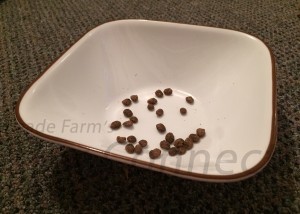Last Updated on October 29, 2022.

Variation Between Animals
- Hedgehogs will eat different amounts depending on their stage in growth, metabolism, and activity level.
- The quality and type of food also plays a role in how much a hedgehog needs to eat to meet its nutritional requirements. Read our Digestibility and Nutrition article for more information on this topic.
- Environmental stress factors including temperature, noise, light, and travel may vary hedgehog’s eating habits. See our Environmental Stress and Eating document for more information on this topic.
- Unfortunately, there isn’t an exact amount that will determine if your hedgehog is eating enough.
- Using the following guidelines will help you gain a better understanding of your pet’s needs.
Monitor Water Consumption
- Dehydration can become a problem with hedgehogs, just as it can with any other animal.
- Be sure to keep fresh, clean water available to your hedgehog at all times. Water that has sat out more than a day will no longer taste fresh and can grow harmful bacteria.
- Water bowls need to be scrubbed and disinfected every day before adding fresh water. Hedgehogs will kick shavings into the bowl, as well as drop crumbs of food in the water. There will also be occasional bits of feces left behind, so be sure to check on the water bowl both in the morning and before going to bed for the night.
- Water bottles should be cleaned on a daily basis and the spouts should be checked to make sure the flow is good and there is nothing clogging the spout.
- If you notice that your hedgehog suddenly stops drinking water, first be sure that the spout of the bottle works properly, and that the bottle or bowl is clean. Refill the dish or bottle with fresh, cold water.
- Using bottled water (or quality filtered water) will help transition your hedgehog from the breeder’s water to your water.
- A hedgehog may be willing to drink water with 50% Gatorade mixed in but if you try this be sure to offer pure water as well as the mixture. This way the hedgehog has a choice.
- If a hedgehog goes more than just a day or two without drinking water it should be brought to a veterinarian, as it may be necessary to give it I.V. fluids, if dehydration is detected.
Monitor Food Intake
- Hedgehogs may not drink if they do not like the water and if the hedgehog does not drink water, it typically will not eat.
- You should measure your hedgehog’s food when you dish it out and then the next day you can measure any leftovers for an accurate picture of how much food your hedgehog is consuming.
- Each breeder has their own growth rate standards for their herd. Some animals grow faster at the same age as other hedgehogs because of genetics and the hedgehog baby’s diet while they are growing.
- Don’t forget that just because the bowl is empty, it doesn’t mean your hedgehog ate all of the food. Look around in the bedding for any pieces of food that may have been dumped during playtime at night.
- Remember, your hedgehog does not store food like a hamster, so if you find a lot of food scattered around in the cage it is simply wasted and will not be eaten at a later time. It will need to be cleaned up and you must note your hedgehog is not eating as much as you may have thought it would.
- If your hedgehog’s food bowl gets filled with shavings it probably will not want to dig through it to find the food. Be sure your hedgehog’s bowl does not have anything but food in it first thing in the morning as well as before you go to bed at night.
- It is very important to be familiar with how much food your hedgehog eats each day. If you know what is normal for your hedgehog you will quickly recognize when things become abnormal. More information on this subject is in the Amount to Feed article.
HOW MUCH TO FEED VIDEO.: https://youtu.be/k82s_kAAmCw
MONITORING FOOD INTAKE VIDEO.: https://youtu.be/9rZASmW9_Q8
Monitor Output
- Monitoring what comes out of your hedgehog is a good way to determine what is going into your hedgehog. The color, smell, and shape of a bowel movement can give you clues as to exactly what your hedgehog has been eating.
- Every parent knows that a good-sized, well-formed bowel movement is a good sign of a healthy body.
- Teeny-tiny and hard little stools are a sign that your hedgehog may not be eating and drinking enough.
Monitor Physical Appearance & Weight
- Every single day you should pick up your hedgehog and inspect it from nose to tiny tail and from quills to soft tummy.
- Be on the lookout for any changes in your hedgehog’s appearance.
- Such as sunken eyes
- Becoming drawn up on the sides and looking thin
- Raised backbone
- Refer to our Signs of Good Health article for more details on the physical appearance of healthy, well-nourished hedgehogs.
- Read our Weight Log article for more information on how to monitor and evaluate your hedgehog’s weight.
Monitor Behavior
- Leaving your hedgehog’s wheel out of the cage for the first day or two will help in the transition from one home to another.
- Sudden lethargy in a hedgehog is never a good sign.
- For example, if a hedgehog is active one moment and then is suddenly tripping, wobbling, falling or going limp, this would be a good time to call your veterinarian.
- Keep in mind hedgehogs will sleep most of the day and this is perfectly normal.
- After waking up if your hedgehog does not react to you or appears limp, check to see if it is too cold or too hot, and then contact your veterinarian immediately.
Contributors:
Gail Smith, Rebekah Scarola, Briar Patch Hedgehogs; Shelly Fowler, Beach Bum Hedgies; Shannon Orth, Dreamflower Meadows, Melissa Ramos





